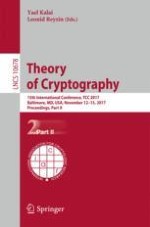2017 | OriginalPaper | Buchkapitel
Verifiable Random Functions from Non-interactive Witness-Indistinguishable Proofs
verfasst von : Nir Bitansky
Erschienen in: Theory of Cryptography
Aktivieren Sie unsere intelligente Suche, um passende Fachinhalte oder Patente zu finden.
Wählen Sie Textabschnitte aus um mit Künstlicher Intelligenz passenden Patente zu finden. powered by
Markieren Sie Textabschnitte, um KI-gestützt weitere passende Inhalte zu finden. powered by
Abstract
-
A selectively-secure VRF assuming NIWIs and non-interactive commitments. As usual, the VRF can be made adaptively-secure assuming subexponential hardness of the underlying primitives.
-
An adaptively-secure VRF assuming (polynomially-hard) NIWIs, noninteractive commitments, and (single-key) constrained pseudorandom functions for a restricted class of constraints.
